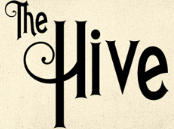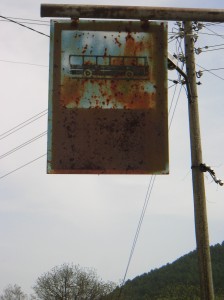 I first encountered Tom Pow’s dying villages work at the Edinburgh Poetry Library, on a tour with the Poetry Translation Centre. I was fascinated by the Cornell-like collections of simple objects, small shrines to the lives once lived in the villages in which they were found. Very curious about his project, I bought two small books, the letterpress-printed Songs from a Dying Village and the equally beautiful Cean Loch Reasort and Other Dead Village Walks, both printed in limited editions. Shortly thereafter, Tom and I began the email correspondence that eventually led to this conversation.
I first encountered Tom Pow’s dying villages work at the Edinburgh Poetry Library, on a tour with the Poetry Translation Centre. I was fascinated by the Cornell-like collections of simple objects, small shrines to the lives once lived in the villages in which they were found. Very curious about his project, I bought two small books, the letterpress-printed Songs from a Dying Village and the equally beautiful Cean Loch Reasort and Other Dead Village Walks, both printed in limited editions. Shortly thereafter, Tom and I began the email correspondence that eventually led to this conversation.
Tom Pow is very much a multidisciplinary poet and artist, as he explains below, and the photographs that accompany this interview were taken on his travels through the dying villages of Europe, as part of his series “Signs of a Dying Village.”
DS
OOO
Tell me, briefly, about dying villages. What are they?
It is estimated that by 2030 Europe will lose roughly one third of its population, the greatest demographic change since the Black Death. The effects of depopulation will be felt most acutely in rural areas, as a result of high levels of emigration to cities and low birth rates. Europe is home to 22 of the world’s 25 lowest birthrate countries, so there are many areas where villages are dying. I travelled to northern Spain, central France, southern Italy, eastern Germany, Bulgaria and central Russia. In Russia, for example, according to recent statistics, 11,000 villages and 290 cities have disappeared from the map of the Russian Federation. 13,000 villages remain on the map, but have no inhabitants. I came across a village there with one surviving inhabitant. This is not unusual.
How did you hear of them? How did that initial impulse—the spark of interest in the dying villages—evolve into the project it now is?
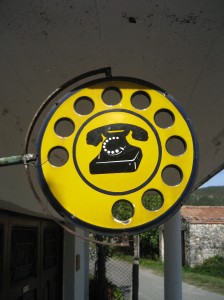 I was in Edmonton for the 30th anniversary of the University of Alberta’s Writing Program for which I’d been a visiting fellow in the early 90s. There was an article in the Edmonton Journal, with the title Withering Heights. It was about a village in northern Spain called Villabandin which had a handful of inhabitants all in their 60s and older. I learned that the phenomenon of the dying village is widespread in Europe and the subject gripped me—history, memory, loss, identity: very Scottish themes, I think! I was given a Creative Scotland Award, which funded my research trips and I began at Villabandin.
I was in Edmonton for the 30th anniversary of the University of Alberta’s Writing Program for which I’d been a visiting fellow in the early 90s. There was an article in the Edmonton Journal, with the title Withering Heights. It was about a village in northern Spain called Villabandin which had a handful of inhabitants all in their 60s and older. I learned that the phenomenon of the dying village is widespread in Europe and the subject gripped me—history, memory, loss, identity: very Scottish themes, I think! I was given a Creative Scotland Award, which funded my research trips and I began at Villabandin.
What do we stand to lose with the death of so many villages? Do you think dying villages contribute to a larger cultural attrition?
I’ve just read that 84% of people in Sweden live on 1.3% of the land. That is a sign of the increasing urbanisation that exists throughout the world. Villages die. Villages have always died, when they can no longer find reasons to exist. What is undoubtedly lost with the deaths of so many villages is a myriad of ways of looking at the world. But what is perhaps more concerning is the future of our relationship with the natural world—a world more and more people are distanced from and with which fewer and fewer have an intimate relationship.
You do more than just write poems, right? You also take photographs, collect artefacts, and more. How does your poetry interact with those other forms or disciplines of remembrance?
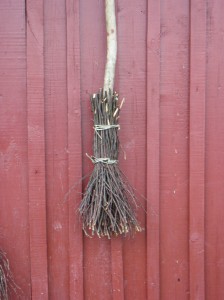 The photographs and the sound recordings were part of the research—they are a kind of noticing. But they also reflect my interests: for example, there are many photographs of doors and windows (thresholds), of what is worn and decayed; the recordings reflect an interest in the texture/the impossibility of silence. The website makes much of this material available. The artefacts grow from the poetry. I see them as physical embodiments of the poems. For example, one of the signs of a dying village is fruit lying unpicked. I came across an arrangement of apples that reminded me of the French game of boules. I showed the photograph to a sculptor and she made three apples on the edge of decay which were then cast in foundry bronze. I call then Boules from a Dying Village. They are beautiful to handle. After they were made, I discovered Gustave Courbet’s still lifes of apples which he painted while in prison. They are acknowledged as rustic memories of the village where he was born and spent his childhood. Each of the artefacts has similarly rich resonances.
The photographs and the sound recordings were part of the research—they are a kind of noticing. But they also reflect my interests: for example, there are many photographs of doors and windows (thresholds), of what is worn and decayed; the recordings reflect an interest in the texture/the impossibility of silence. The website makes much of this material available. The artefacts grow from the poetry. I see them as physical embodiments of the poems. For example, one of the signs of a dying village is fruit lying unpicked. I came across an arrangement of apples that reminded me of the French game of boules. I showed the photograph to a sculptor and she made three apples on the edge of decay which were then cast in foundry bronze. I call then Boules from a Dying Village. They are beautiful to handle. After they were made, I discovered Gustave Courbet’s still lifes of apples which he painted while in prison. They are acknowledged as rustic memories of the village where he was born and spent his childhood. Each of the artefacts has similarly rich resonances.
People love to bemoan the state of poetry; I hate listening to them. Tell me about how the medium of poetry worked (or didn’t) for this project?
John Berger writes, in And Our Faces, My heart, Brief as Photos, that prose is a battle and that poetry moves through the battlefield tending the wounds. Poetry can still the narrative, so that something can be looked at and considered—given due attention. Some of the pieces I wrote were very short—poems of three or four lines. They are sequences with, I hope, a cumulative power. But each of them offers a threshold into the world of the dying village:
She’s sitting on the old green bench
by the side of the lilac tree.
Oh, the songs she once sung here!
The thought of them still makes her blush.
OOOO(from Songs from a Dying Village)
Did the project—and especially the travel portion of it, actually visiting these communities—affect your writing? What did you learn?
 Of course. The small poem above is part of a sequence that drew on the Russian folk poem, the chastushka, a short lyric that was sung and that reflected village life. So common was it that the Soviets high-jacked it and used it as a way of spreading propaganda. My poems drew on what I read, but also on field work in Russia, listening to old women singing these songs.
Of course. The small poem above is part of a sequence that drew on the Russian folk poem, the chastushka, a short lyric that was sung and that reflected village life. So common was it that the Soviets high-jacked it and used it as a way of spreading propaganda. My poems drew on what I read, but also on field work in Russia, listening to old women singing these songs.
What’s the future of the dying villages project?
I have begun a series of intimate engagements, using my Suitcase of the Dying Village. These are events/presentations round a table of 12-15 people. I share photographs, artefacts, recordings, read poems and tell stories relating to the project. There is always time to engage with others’ experiences and memories and there is opportunity for them to write very briefly about their connection with a (dying) village. At one of these events, after the presentation, we served soup, bread and cheese. I like to think I am creating a space for people to engage with the subject in their own ways. And I suppose there is something about the intimacy that fits the subject. On the other hand, I have also given talks/lectures to fairly large audiences about the subject. I am working on a book about dying villages in Europe, which will be published in 2011. The book will contain travel essays, poems and short stories. But I’d like to go on one further dying villages trip.
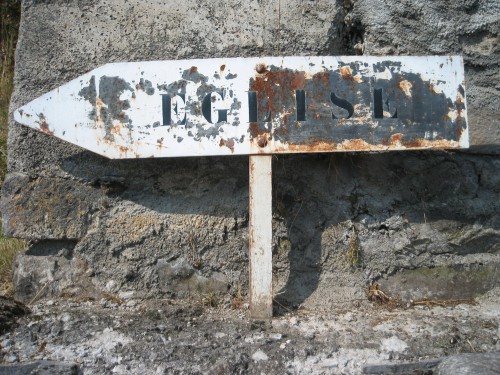 What do you take with you on the road? Any specific books or albums? Have you picked up anything great recently?
What do you take with you on the road? Any specific books or albums? Have you picked up anything great recently?
Travelling can be a good time to read things you’ve been meaning to read for some time and never got round to. On one of the trips I took Gaston Bachelar’s The Poetics of Space. It started me writing a sequence of short poems about nests. I’d thought they were an escape from the enormity of the dying villages project. But I came to realise that nests are intimately connected to the themes of home and of abandonment that are at the heart of dying villages.
A nest is a blessing
for a tree and a prayer
upon the water.
December 2010

 Fiona Sampson was first a concert violinist, then studied at the Universities of Oxford, where she won the Newdigate Prize, and Nijmegen, where she received a PhD in the philosophy of language. This research arose from her pioneering residencies in health care. She has published seventeen books, including Rough Music (short-listed for the Forward Prize and T.S. Eliot Prize 2010) and A Century of Poetry Review (PBS Special Commendation, 2009). She was the founding editor of Orient Express, a journal of contemporary writing from post-communist Europe, and her other translations include books by Amir Or and Jaan Kaplinski. Published in more than thirty languages, she has eleven books in translation including Patuvachki Dnevnik, awarded the Zlaten Prsten (Macedonia). She has received Writer’s Awards from the Arts Councils of England and Wales and the Society of Authors, the US Literary Review’s Charles Angoff Award, and was AHRC Research Fellow at Oxford Brookes University 2002-5 and CAPITAL Fellow in Creativity at the University of Warwick 2007-8. Fiona Sampson is the editor of Poetry Review, the UK’s oldest and most influential poetry journal, and contributes regularly to The Guardian, The Irish Times, The Independent and the TLS. In 2009, she received a Cholmondeley Award and became a Fellow of the Royal Society for Literature. She is Distinguished Writer at the University of Kingston, and her books forthcoming in May 2011 are Music Lessons: the Newcastle Poetry Lectures, and Percy Bysshe Shelley in the Faber poet-to-poet series.
Fiona Sampson was first a concert violinist, then studied at the Universities of Oxford, where she won the Newdigate Prize, and Nijmegen, where she received a PhD in the philosophy of language. This research arose from her pioneering residencies in health care. She has published seventeen books, including Rough Music (short-listed for the Forward Prize and T.S. Eliot Prize 2010) and A Century of Poetry Review (PBS Special Commendation, 2009). She was the founding editor of Orient Express, a journal of contemporary writing from post-communist Europe, and her other translations include books by Amir Or and Jaan Kaplinski. Published in more than thirty languages, she has eleven books in translation including Patuvachki Dnevnik, awarded the Zlaten Prsten (Macedonia). She has received Writer’s Awards from the Arts Councils of England and Wales and the Society of Authors, the US Literary Review’s Charles Angoff Award, and was AHRC Research Fellow at Oxford Brookes University 2002-5 and CAPITAL Fellow in Creativity at the University of Warwick 2007-8. Fiona Sampson is the editor of Poetry Review, the UK’s oldest and most influential poetry journal, and contributes regularly to The Guardian, The Irish Times, The Independent and the TLS. In 2009, she received a Cholmondeley Award and became a Fellow of the Royal Society for Literature. She is Distinguished Writer at the University of Kingston, and her books forthcoming in May 2011 are Music Lessons: the Newcastle Poetry Lectures, and Percy Bysshe Shelley in the Faber poet-to-poet series. Mathew Timmons’ latest book, The New Poetics ($15), published by
Mathew Timmons’ latest book, The New Poetics ($15), published by 
 Carol Moldaw’s most recent book is So Late, So Soon: New and Selected Poems (Etruscan Press, 2010). She is the author of four other books of poetry, The Lightning Field, which won the 2002 FIELD Poetry Prize, Through the Window, Chalkmarks on Stone, and Taken from the River, as well as a novel, The Widening (2008). Through the Window was translated into Turkish and published in a bi-lingual edition in Istanbul as Penceredon/Through the Window; her work also has been translated into Chinese and Portuguese. Moldaw is the recipient of a Lannan Foundation Marfa Writer’s Residency, an NEA Creative Writing Fellowship, and a Pushcart Prize, and her work is published widely in journals, including AGNI, Antioch Review, Boston Review, Chicago Review, Conjunctions, Denver Quarterly, FIELD, The New Republic, The New Yorker, The Paris Review, Parnassus, Threepenny Review, and Triquarterly and has been anthologized in many venues, including Western Wind: An Introduction to Poetry, and Under 35: A New Generation of American Poets. As noted in The New Yorker, Moldaw’s work “repeatedly achieves lyric junctures of shivering beauty.” About The Lightning Field, Frieda Gardner wrote in The Women’s Review of Books: “She courts revelation . . . in a voice variously curious, passionate, surprised, meditative, and sensual. On the surface of her work are rich sound and variation of rhythm and line. A few steps deeper in lie wells of feeling and complexities of thought.” From 2005-2008 Moldaw was on the faculty of Stonecoast, the University of Southern Maine’s low-residency M.F.A. program, and she has conducted residencies at the Vermont Studio Center, taught at the College of Santa Fe and in the MFA program at Naropa University. Moldaw lives outside of Santa Fe, New Mexico with her husband and daughter. In the spring of 2011 she will be the Louis D. Rubin, Jr., Writer-in-Residence at Hollins University.
Carol Moldaw’s most recent book is So Late, So Soon: New and Selected Poems (Etruscan Press, 2010). She is the author of four other books of poetry, The Lightning Field, which won the 2002 FIELD Poetry Prize, Through the Window, Chalkmarks on Stone, and Taken from the River, as well as a novel, The Widening (2008). Through the Window was translated into Turkish and published in a bi-lingual edition in Istanbul as Penceredon/Through the Window; her work also has been translated into Chinese and Portuguese. Moldaw is the recipient of a Lannan Foundation Marfa Writer’s Residency, an NEA Creative Writing Fellowship, and a Pushcart Prize, and her work is published widely in journals, including AGNI, Antioch Review, Boston Review, Chicago Review, Conjunctions, Denver Quarterly, FIELD, The New Republic, The New Yorker, The Paris Review, Parnassus, Threepenny Review, and Triquarterly and has been anthologized in many venues, including Western Wind: An Introduction to Poetry, and Under 35: A New Generation of American Poets. As noted in The New Yorker, Moldaw’s work “repeatedly achieves lyric junctures of shivering beauty.” About The Lightning Field, Frieda Gardner wrote in The Women’s Review of Books: “She courts revelation . . . in a voice variously curious, passionate, surprised, meditative, and sensual. On the surface of her work are rich sound and variation of rhythm and line. A few steps deeper in lie wells of feeling and complexities of thought.” From 2005-2008 Moldaw was on the faculty of Stonecoast, the University of Southern Maine’s low-residency M.F.A. program, and she has conducted residencies at the Vermont Studio Center, taught at the College of Santa Fe and in the MFA program at Naropa University. Moldaw lives outside of Santa Fe, New Mexico with her husband and daughter. In the spring of 2011 she will be the Louis D. Rubin, Jr., Writer-in-Residence at Hollins University.

 Arthur Sze is the author of nine books of poetry, including The Ginkgo Light (2009), Quipu (2005), The Redshifting Web: Poems 1970-1998 (1998), Archipelago (1995), and The Silk Dragon: Translations from the Chinese (2001) from Copper Canyon Press. He is also the editor of Chinese Writers on Writing (Trinity University Press, Texas, 2010). A professor emeritus at the Institute of American Indian Arts, where he taught for twenty years, Mr. Sze was Poet Laureate of Santa Fe from 2006-2008. He is the recipient of numerous awards, including a PEN Southwest Book Award, a Lila Wallace-Reader’s Digest Writers’ Award, a Guggenheim Fellowship, a Lannan Literary Award, an American Book Award, and two National Endowment for the Arts Creative Writing fellowships. His poems have been translated into Albanian, Burmese, Chinese, Dutch, Italian, Portugese, Romanian, Spanish, and Turkish, and he has read his poetry at such international festivals as the XIX International Poetry Festival of Medellín (2009), the Delhi International Literary Festival (2008), the Yellow Mountain Poetry Festival in England (2008), the Yellow Mountain Poetry Festival in China (2007), the Pacific International Poetry Festival (Taiwan, 2008), Poetry International (Rotterdam, 2007), and the Hong Kong International Literary Festival (2002).
Arthur Sze is the author of nine books of poetry, including The Ginkgo Light (2009), Quipu (2005), The Redshifting Web: Poems 1970-1998 (1998), Archipelago (1995), and The Silk Dragon: Translations from the Chinese (2001) from Copper Canyon Press. He is also the editor of Chinese Writers on Writing (Trinity University Press, Texas, 2010). A professor emeritus at the Institute of American Indian Arts, where he taught for twenty years, Mr. Sze was Poet Laureate of Santa Fe from 2006-2008. He is the recipient of numerous awards, including a PEN Southwest Book Award, a Lila Wallace-Reader’s Digest Writers’ Award, a Guggenheim Fellowship, a Lannan Literary Award, an American Book Award, and two National Endowment for the Arts Creative Writing fellowships. His poems have been translated into Albanian, Burmese, Chinese, Dutch, Italian, Portugese, Romanian, Spanish, and Turkish, and he has read his poetry at such international festivals as the XIX International Poetry Festival of Medellín (2009), the Delhi International Literary Festival (2008), the Yellow Mountain Poetry Festival in England (2008), the Yellow Mountain Poetry Festival in China (2007), the Pacific International Poetry Festival (Taiwan, 2008), Poetry International (Rotterdam, 2007), and the Hong Kong International Literary Festival (2002). I was introduced to Travis Elborough by poet and translator Sarah Maguire, of the Poetry Translation Centre, with a simple sentence: “Travis Elborough is a cult.” Though I didn’t know what it meant at the time, I was happy to be spoiled by the tour manager of our Mexican Poets’ Tour through the UK. Travis was more than mere manager; he combined the best aspects of tour guide, curatorial critic, and lomography photographer. During that time, in April 2010, Travis was working on the final edits of his latest book, Wish You Were Here (Sceptre, £14.99), which followed his critically acclaimed social histories of the vinyl record—The Longplayer Goodbye—and the iconic double-decker buses of London—The Bus We Loved. We corresponded informally about his latest book over the course of a couple months before the following exchange, conducted by email. Travis generously supplied his own photographs of the British seaside, featured throughout the interview.
I was introduced to Travis Elborough by poet and translator Sarah Maguire, of the Poetry Translation Centre, with a simple sentence: “Travis Elborough is a cult.” Though I didn’t know what it meant at the time, I was happy to be spoiled by the tour manager of our Mexican Poets’ Tour through the UK. Travis was more than mere manager; he combined the best aspects of tour guide, curatorial critic, and lomography photographer. During that time, in April 2010, Travis was working on the final edits of his latest book, Wish You Were Here (Sceptre, £14.99), which followed his critically acclaimed social histories of the vinyl record—The Longplayer Goodbye—and the iconic double-decker buses of London—The Bus We Loved. We corresponded informally about his latest book over the course of a couple months before the following exchange, conducted by email. Travis generously supplied his own photographs of the British seaside, featured throughout the interview. 





 The San Francisco-based Center for the Art of Translation publishes Two Lines each year, its contents selected quite curatorially by a tandem of guest editors. The newest edition was assembled by notable Bolaño translator Natasha Wimmers and New Directions editor Jeffrey Yang. Still published in its strange horizontal format, the book-style magazine collects the best work of working translators. Highlights of this issue include Bolaño’s short note on the importance of translation, which perfectly accompanies
The San Francisco-based Center for the Art of Translation publishes Two Lines each year, its contents selected quite curatorially by a tandem of guest editors. The newest edition was assembled by notable Bolaño translator Natasha Wimmers and New Directions editor Jeffrey Yang. Still published in its strange horizontal format, the book-style magazine collects the best work of working translators. Highlights of this issue include Bolaño’s short note on the importance of translation, which perfectly accompanies  Like Two Lines, Signal culls the best and most interesting material from around the world. Using interview as their primary method, the editors allow practitioners to speak for themselves, be they the Xicana printmakers of Taller Tupac Amaru, Johannes van de Weert, the Dutch creator of Red Rat, an influential comic during the rise of the Dutch punk scene in the 1980s, Felipe Hernandez Moreno, a printmaker in his 70s who participated in the Mexican Student Movement of 1968, or Rufus Segar, who designed almost every cover of the 1960s magazine Anarchy.
Like Two Lines, Signal culls the best and most interesting material from around the world. Using interview as their primary method, the editors allow practitioners to speak for themselves, be they the Xicana printmakers of Taller Tupac Amaru, Johannes van de Weert, the Dutch creator of Red Rat, an influential comic during the rise of the Dutch punk scene in the 1980s, Felipe Hernandez Moreno, a printmaker in his 70s who participated in the Mexican Student Movement of 1968, or Rufus Segar, who designed almost every cover of the 1960s magazine Anarchy.





